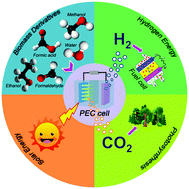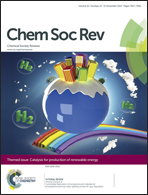Photoelectrochemical hydrogen production from biomass derivatives and water
Abstract
Hydrogen, a clean energy carrier with high energy capacity, is a very promising candidate as a primary energy source for the future. Photoelectrochemical (PEC) hydrogen production from renewable biomass derivatives and water is one of the most promising approaches to producing green chemical fuel. Compared to water splitting, hydrogen production from renewable biomass derivatives and water through a PEC process is more efficient from the viewpoint of thermodynamics. Additionally, the carbon dioxide formed can be re-transformed into carbohydrates via photosynthesis in plants. In this review, we focus on the development of photoanodes and systems for PEC hydrogen production from water and renewable biomass derivatives, such as methanol, ethanol, glycerol and sugars. We also discuss the future challenges and opportunities for the design of the state-of-the-art photoanodes and PEC systems for hydrogen production from biomass derivatives and water.

- This article is part of the themed collection: Catalysis for Production of Renewable Energy

 Please wait while we load your content...
Please wait while we load your content...